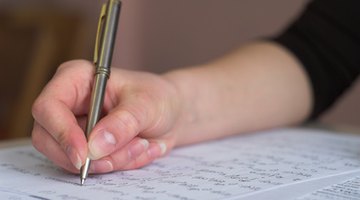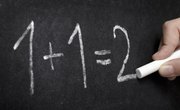The Cognitive Abilities Test (CogAT) differs greatly from other standardized tests that students will take during their academic careers. Unlike achievement tests such as the SATs, the CogATs do not measure how much a student has learned, but focuses instead on a student's ability to display cognitive abilities that research have associated with academic success. These abilities include reasoning and problem solving using verbal, quantitative and spatial (non-verbal) methods to find the answers. Preparing for the CogAT can be trickier than simply memorizing equations or facts, but can be done with some practice.
Prepare for Verbal-Reasoning Questions
Step 1
Study relationships between words. One set of questions on the CogAT will provide students with a list of words that have something in common. For example, students may be presented with the list "dog, cat, bird." Students are then given a list of five words, and told to choose the word that most logically fits into the first list. From the list "tree, house, pet, horse, computer" students would pick horse, because all of the words are animals.
Step 2
Practice sentence completion exercises with words at the student's grade level. Because the CogAT can be administered at any time between kindergarten and high school graduation, this study will vary by student level. Students will be given sentences like "Snow ___ under the sun," followed by a list of words: "freezes, sits, melts, cools, hardens." Students have to pick the most logical word to complete the sentence: in this case, melts.
Step 3
Practice solving analogies. Analogies are word problems that compare two words and ask the test-taker to compare other words the same way. For instance, students will be given a problem such as "new is to old as wet is to ___" and asked to choose the appropriate word that fits the analogy: "damp, moist, dry, hot." Because new and are opposite, choose the opposite of wet: dry.
Prepare for Quantitative-Reasoning Questions
Step 1
Study the meanings of greater than, less than and equal to. In one section of the test, students will be given two separate math problems relative to their grade level ability. One problem will be labeled with a number one, and the second with number two: 1. 3 + 1 2. 7 -- 3. Students have to solve each problem and decide whether the first is greater than, less than or equal to the second. In this instance the two problems are equal, since they both come out to four.
Step 2
Practice counting in series. Students will be given a series of numbers (2, 4, 8, 16, __) and asked to choose from a list of numbers which comes next. In this instance the next number is 32, since the list multiplies each number by two to get the next number.
Step 3
Understand the mathematical symbols and what they mean. Students will be given a series of numbers and mathematical symbols (0 4 7 + - ). Students must arrange these numbers and symbols to fit one of the five answer choices given (0, 2, 3, 12, 28). This problem can read 7 -- 4 + 0 to equal 3, one of the answer choices.
Prepare for Spatial-Reasoning Questions
Step 1
Study relationships between shapes, colors and other physical representations. In one section of the COGAT, the test-taker will see a group of designs that have something in common and must choose the design from the answers that belongs in that group. Designs can be grouped by shape, shading or color.
Step 2
Prepare for analogies that will compare designs instead of words. Students will be shown two shapes that relate to each other (a green triangle and a green circle) and one shape that they have to relate to the one of the answer choices (a red square). The student would choose whichever answer choice was red, since the first two shared the same color.
Step 3
Practice with folding pieces of paper for an analysis section. Students will be shown folded pieces of paper with holes punched into certain areas and must choose from the answers what the paper would like when it was unfolded.
Related Articles
References
Writer Bio
Samantha Volz has been involved in journalistic and informative writing for over eight years. She holds a bachelor's degree in English literature from Lycoming College, Williamsport, Pennsylvania, with a minor in European history. In college she was editor-in-chief of the student newspaper and completed a professional internship with the "Williamsport Sun-Gazette," serving as a full-time reporter. She resides in Horsham, Pennsylvania.











